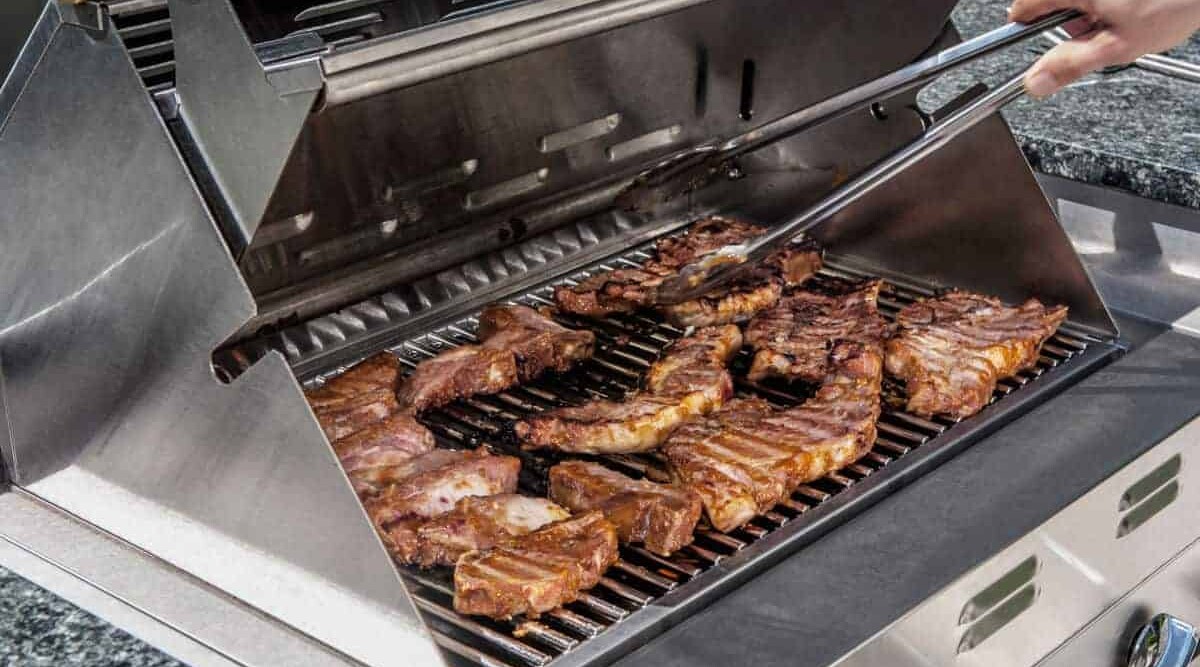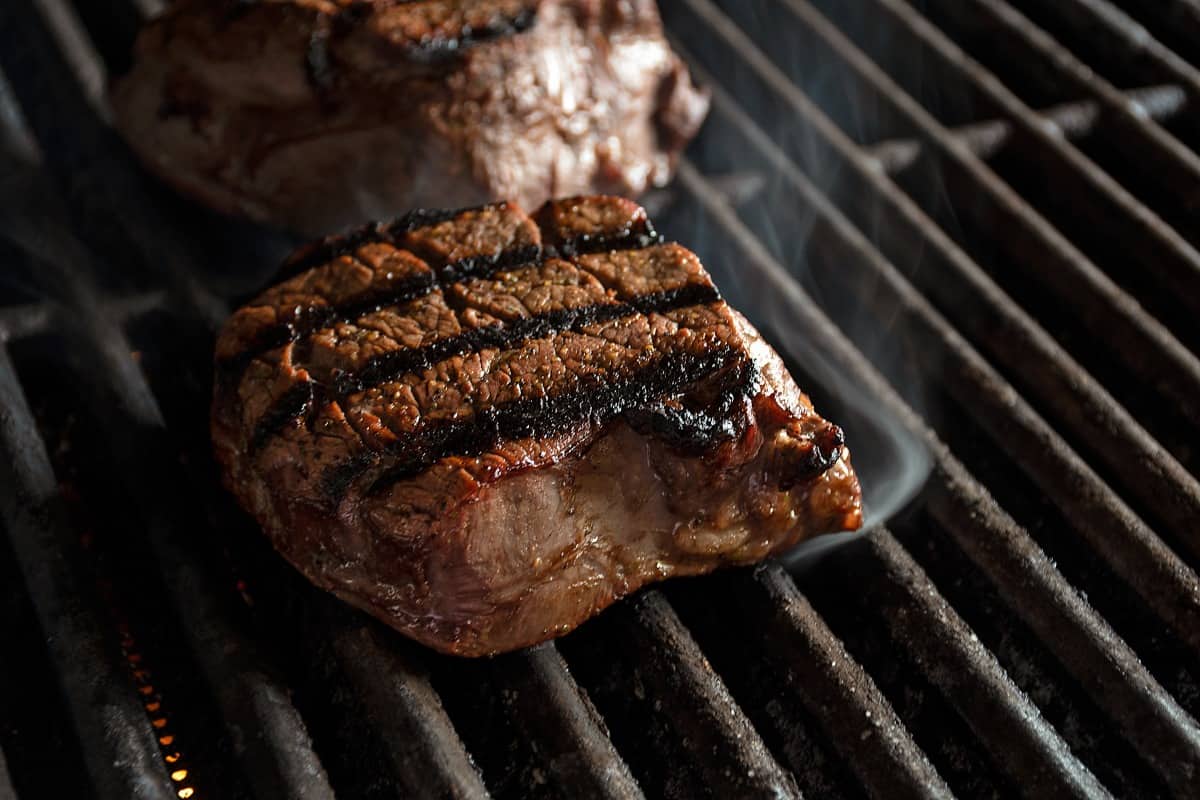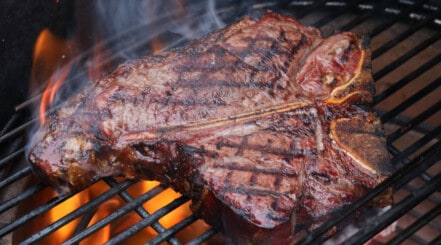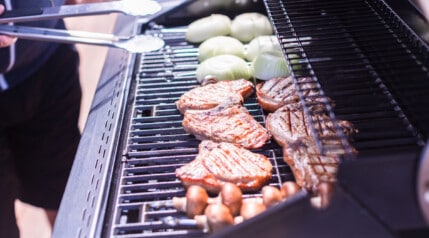
In the ongoing search for the perfect home-cooked steak and the most efficient way to cook, many a seasoned griller has turned to infrared grills.
With its super quick high heat, many are saying it’s the best way to cook a steak and keep it juicy.
In this article, we’re going to give you the lowdown on infrared grills — advantages, disadvantages, and how they work.
Namely, what they are, how exactly they do what they do, whether they are any good, and ultimately, whether you should spend some of your hard-earned cash to purchase one.
In simple terms, infrared grills heat something directly with radiant heat, as opposed to the traditional way of heating the air and letting that cook the food. Quicker, more efficient, and tastier.
But, is it as amazing as it sounds? Let’s find out.
Jump to:
What is an Infrared Grill? How do They Work?
To understand this fully we need to understand the difference between infrared and your usual go-to cooking method, which is usually either grilling with charcoal or gas-fired grilling.
Both these methods are convection cooking, in that the charcoal or gas flames heat the air between the fire and the food.
This hot air circulates around the food as it heats, which is known as a convection current.
This is the reason you close the lid while cooking, as it stops the hot air from escaping and allows the temperature to sit at a reasonably constant temperature, much like a traditional oven.
Infrared is different.
In simple terms, it is part of the electromagnetic spectrum, which measures the length and speed of waves. Only a small part of the spectrum is visible to the human eye as visible light, and IR, is just outside this scope, and thus it is invisible to us. However, because it heats things, we can feel, see and taste the effect of it.
It is a lot like the sun. The sun’s energy is made up of around 50% infrared, and this is why pavements are hot to the touch in summer, yet we cannot see the heating process.
An IR grill uses a gas burner to heat a plate made of metal, ceramic, or glass and in turn produces infrared waves as opposed to just hot air. This plate heats quicker than just air and reaches a much higher temperature much faster.
The infrared waves created are what heats the surface of an object, such as meat, quicker than circulating hot air can.
You might like to check out this video from BBQGuys for a good visual overview and further discussion:
Advantages of Infrared Grills
Here are the main advantages of cooking with an IR grill.
Speed
Infrared grills heat up quickly, not just a bit quicker, we’re talking 2 to 3 minutes compared to 10 minutes for a gas grill and up to 30 minutes for a charcoal one. The reason is direct heat to the plate.
With convection cooking, we float the food above air that has been heated.
With infrared, the plate goes directly onto the flame. As the plate heats up and retains heat, it emits IR rays. In turn, as soon as the food is placed onto the plate, the IR rays start to cook the food immediately.
So, no more waiting for the grill to heat up for 30 minutes to use it for just 10 minutes for a couple of steaks. Start to finish, from switching on to putting the steak on your plate, could be as little as 8 to 10 minutes.
Higher Temperatures

But why is this important when your traditional grill gets plenty hot enough? Well, there is some science behind an even hotter grill being better for your steaks.
An infrared grill can hit temperatures of up to 1200f compared to a good quality grill that will reach 700 to 750f.
For a steak to remain succulent it needs to retain as much of its juices as possible. The longer we cook something, the more moisture it loses. And in that respect the hotter the grill, the quicker it sears, the less juice it loses in the process.
Energy Efficiency
As a direct result of the shorter heat-up time, higher heat, and quicker cooking time, much less energy is used.
An infrared grill can be up to twice as fast (if not more!) as a traditional gas grill and could, therefore, use up to 50% less gas.
So, if you’re looking to reduce your carbon footprintit could be a big step in the right direction compared to more typical charcoal grills or wood-burning grills, and it will save you a few dollars in the process.
Everyone’s a winner!
Disadvantages of Infrared Grills
Every yin has its yang, so here are some of the disadvantages to an infrared grill.
Not Very Versatile
Although an infrared grill could take your steak cooking skills to another level, popular opinion is that this is about all it will do.
With the crazy high temperatures it can reach, the grill can be somewhat difficult to master when it comes to the time-temperature relationship.
In addition to this, it doesn’t offer the lower temperatures that a traditional gas or charcoal grill does.
In contrast, other more traditional grills can offer as low as 100f at the low-end, which is great for slow cooking meats, whereas an infrared grill only goes as low as 250f.
This means that delicately cooked foods such as fish and vegetables cannot be cooked on the infrared grill.
Heavy and Immobile
Infrared grills were traditionally designed for commercial kitchens to give them an efficient and constant grilling surface for steaks and such things. As such, they weren’t designed to be portable or light.
The new phase of IR grills for the home, although smaller, are still not as light and portable as we’ve come to expect of our gas and charcoal grills.
The infrared plates are heavy by design, and the ‘portable’ ones are still heavy and not designed for moving between various cooking spots or as a camp grill.
Expensive
Just like most new technologies, infrared grills come at a cost. With a unit comparable in size to a 4-burner gas grill costing anywhere from $1000 up to $3000, they aren’t the cheapest option.
There are portable smaller infrared grills available from around $500. But as stated before, they have a limited use and often a shorter lifespan if used for extended cookouts, making them far costlier than traditional grills.
Why Might You Want One? Who are Infrared Grills Best Suited to?
So, who would want one of these grills?
Well, if you’re looking for the cooking method that can give you the best steak experience consistently, then an infrared grill could be a welcome addition to your grill collection.
Or, if patience is not your strongest trait, then infrared can save you a lot of time, and deliver your dinner much quicker!
Maybe you like to keep on top of new technology and impress your guests? If so, an infrared grill would do precisely that.
These grills could also be well-suited to those that have cooked on an industrial scale before and who regularly host and grill for large groups.
Conclusion
These grills really do divide opinion.
For many, the infrared grill is a one-trick pony that can only really be used for searing steaks and other such meats. They’ve burnt a lot of delicate foods, and many simply see them as a new technology that is overpriced.
On the other hand, others that have taken the time to hone their skills on an infrared grill believe them to be the next best thing for cooking with.
From what we’ve seen, we believe it to be somewhere in the middle. The infrared grill is a convenient and fuel-efficient piece of equipment that, with some time and patience, can be used to produce some fine foods, as well as saving money on your gas bill.
If you have an infrared grill and experience using one, let us know your thoughts about them in the comments below.






Is it possible to set up 2-zone cooking on an infrared grill?
As long as you can have a hot side and a cool side (or a side with burner on, and a side with burners off) then sure. I would need to see your specific grill, it’s burners and set up to be able to say for sure.
I have had a charbroil 2 burner tru infrared grill for over 5 years and I love it. Your article about steaks is right on. My steaks are as good as any fine quality restaurant. I have cooked chicken, using the lowest flame setting, Italian sausage, vegetables on a grilling plate and all turned out wonderful. I have cooked fish, wrapped in aluminum foil, and it turned out great, again using the lowest setting. The one feature I love the most is no flare ups since there is no open flame. I highly recommend the infra red grill.
I’ve had a Saber 3 burner for 3 years, but I’m not a fan. It heats quickly and sears well, but I don’t care for the flavor that infrared grills impart on the meats, no matter beef, pork, chicken – whatever. I’ve tried all heat ranges and yet the meats take on an odd flavor. My assumption is that the smoke from the fats doesn’t get oxidized as well as on conventional grills, as the smoke is generated immediately next to the meat instead of a few inches below the grill. Just a guess, but that’s my take on it.
I purchased a Char Broil 2 burner Tru-Infrared grill about 3 years ago. I like everything about it. Works just as well as it did the day I purchased it. Was under $300.
My wife and I recently purchased a CharBoil electric infrared grill for under $200. She does stakes, chicken, fish and a variety of vegetables. Cooking time is critical, fish is very short, vegitables take longer. Best squash I’ve ever had. I highly recommend this grill
I have a Char-Broil Infrared Commercial model. Hate the infrared plates with the little holes that need to be cleaned after every use.
Further to the CharBroil Infrared Commercial – would like to get rid of the plates & replace with something else – any suggestions? Our daughter has the non commercial CB Infrared – it has a collection pan under the cooking grates – good setup. Hoped I could do that with my Commercial model but size of the cooking box is the problem – is different. Also replacing the Infrared plates $$$. Don’t know what I’ll do with it – recycle maybe…
I’ve used Char Broil infrared grills for the past decade – and absolutely LOVE them for any grilling. I’ve never had an issue with difficulty cooking at low temps…maybe a lower end maker like Char Broil is superior to all the really high priced ones! So I’m not sure if there are any disadvantages: it routinely cranks out 800° within 10 minutes of start up in New England winter.
Since it’s a propane grill, you obviously shouldn’t use for low and slow bbq…that’s why we have pellet and charcoal.
I purchased a Solaire gas grill that has both gas and infrared possibilities which makes it very versatile. 17 years later, the gas cartridges are still in the shrink wrap! One way optimize the benefits beyond a steak or burger–is to use fire brick (get the 1″ brick at masonry supply) or a baking stone. I spatchcock my chicken and put them directly on the stone (or an inverted meat rack). The skin is crisp (I salt and use spice rubs of my choice) and the meat is succulent. I cook my TG Turkey this way. Next meal, flip the stone to burn off last meal and start with new. I evangelize this method because the results really are that good.
As with most cooking methods, you have to understand and adapt–and that includes a few misfires. Honestly, for burgers/steaks, I use my carbon steel pan for perfect sear.
Dislike the infrared grill very much the fine screen has to be cleaned after every use cause the holes are so fine. A real pain!!!